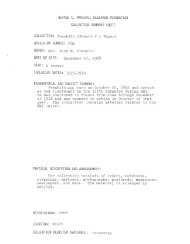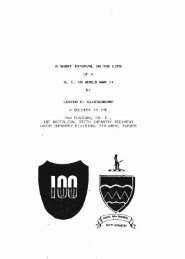Joint Operating Concept (JOC) - GlobalSecurity.org
Joint Operating Concept (JOC) - GlobalSecurity.org
Joint Operating Concept (JOC) - GlobalSecurity.org
Create successful ePaper yourself
Turn your PDF publications into a flip-book with our unique Google optimized e-Paper software.
• Focus on addressing the underlying economic, political, cultural, or<br />
security conditions that fuel the grievances of the population, rather than<br />
on applying military power directly against the military and paramilitary<br />
forces of adversaries. Both approaches are necessary, but the direct<br />
application of military power is unlikely to be decisive.<br />
• Disrupt, dislocate, and defeat adversaries by attacking them physically<br />
and psychologically where they are most vulnerable and unsuspecting,<br />
rather than attacking where they are strongest or in the manner they<br />
expect.<br />
• Empower, enable, support, or leverage IA and other partners to attack<br />
adversaries militarily or confront them non-militarily, rather than relying<br />
on direct and unilateral military confrontation by US joint forces.<br />
• Take actions with or against third-party states or armed groups in order to<br />
influence adversaries rather than taking actions to influence adversaries<br />
directly.<br />
• Attack 19 adversaries using a combination of conventional and<br />
nonconventional methods and means rather than relying only on<br />
conventional military forces. Nonconventional methods and means might<br />
include clandestine or covert actions, operations in combination with<br />
irregular forces, or the nonconventional use of conventional capabilities.<br />
• Subvert the power and influence of adversaries over the relevant<br />
populations by isolating them physically and psychologically from their<br />
local and international support through the use of PSYOP, public<br />
diplomacy, and public affairs activities; security operations; population<br />
and resource control measures; and other means.<br />
An indirect approach may include direct actions at the tactical level. For<br />
example, a tactical operation, such as a conventional strike against a terrorist<br />
training camp, may be viewed as a direct application of military power. This<br />
same tactical operation may also be conducted as part of a broader indirect<br />
operational or strategic level campaign. This mixture of direct and indirect<br />
applications of military power at the various levels of warfare adds to the<br />
complexity of IW.<br />
An indirect approach does not mean that IW can be conducted without any<br />
direct combat operations to kill or defeat an adversary. Some adversaries, such<br />
as terrorists and insurgents fighting for a religious or tribal cause, may be so<br />
committed that they simply cannot be persuaded or coerced into laying down<br />
their arms; these individuals must be either killed or captured.<br />
Protracted IW Campaigns. IW historically has required a prolonged and<br />
persistent effort of at least a decade to achieve a political outcome. 20 The<br />
19 For the purposes of the <strong>JOC</strong> the term "attack" is used to describe both lethal and non-lethal<br />
means.<br />
20 Sepp, Dr. Kalev I., “Best Practices in Counterinsurgency,” Military Review, 8-12, May-June<br />
2005.<br />
20
















